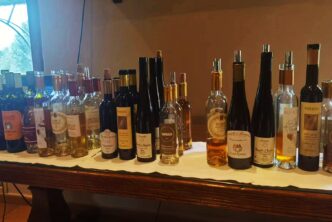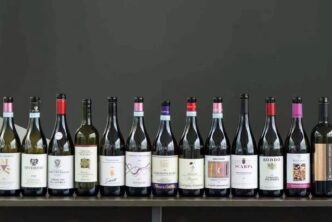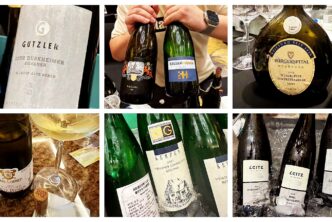In this smaller introductory article on Germany’s new and recently released wines (and some older ones too for context), Yumi Liu provides an introduction to German wine (it’s history, geography, types) and then tasting notes and scores on about thirty wines she recently tasted. Part 2 of this article will appear the following week and be entirely devoted to tasting notes and scores on recent releases only and will see a much larger number of wines (close to one hundred or so) reviewed.
Wine grapes in Germany: Pinot Noir (Spatburgunder) rising!
There are thirteen wine regions in Germany: 99% of the vineyards are located in the Rhine Valley in the southwestern part of the country, with only 1% being found instead in the Saal-Unstunt region. The area planted to vines in Germany as of 2021 is dominated by white grape varieties, which account for 67.8% of the total area under vine, compared to 32.2% of the area planted with red grapes (data from Deutsche Weininstitut).
However, as a result of the global warming trend and the economic demands of the market, Müller-Thurgau, which used to rank second in Germany in terms of hectarage planted, has been replaced by Spätburgunder (Pinot Noir), and so is now only the third most planted grape variety in the country. Interestingly, although Pinot Noir was brought to Lake Constance from Burgundy as early as 884 A.D. by Charles III (grandson of Charlemagne and Emperor of the Holy Roman Empire) and therefore perhaps even earlier than Riesling (the appearance of which in Germany has been officially recorded as being 1435 A.D.), it was not until in recent years that its popularity in the country has taken off. Essentially, Pinot Noir’s rise to prominence in Germany dates back to right after World War II, but it began with the widespread planting of high-yielding, high-sugar Pinot Noir clones that were often more suited to the making of sparkling wines than still red wines. At the time, nobody was really doing any biotype identification or massal selections, so what was planted in the aftermath of the war were mostly nursery clones characterized by thin-skinned, tightly packed grapes. One consequence of this poor viticultural decision was that the vineyards were easily ravaged by moulds. Another was that the wine produced was very light in color and lacked flavour and structure. All of which explains why German Pinot Noir wines (Spätburgunders as they are called in German) had an extremely poor reputation for a very long time.
The combination of global warming, a deeper grasp of their terroirs and of clonal differences and winemaking technology innovation, ultimately led to the 1980s German Spätburgunder quality renaissance. A small group of forward-thinking producers began to focus on quality, totally committed to enhancing the reputation of German Pinot Noir wines. Among the steps they took, the introduction of better Burgundy Pinot Noir clones (for example, Dijon Clones) or to just buy plants from their good friends who were winemakers in Burgundy. At the same time, locals began studying Germany’s ancient indigenous strains of Pinot Noir in greater depth, with a few winegrowers propagating their own old vines using elite selection methods to select the highest-quality plants. The German research institutes, led by the Universities of Geisenheim and Freiburg, also got into the act, developing new clones that were more disease-resistant and offered a better balance of wine quality and yield.
In this light, it is very much worth mentioning Frühburgunder (also known as Pinot Noir Précoce, or Early Ripening Pinot Noir), a Pinot Noir strain that is uniquely local to Germany. As its name implies, this strain is more early-ripening than regular Pinot Noir, but also has lower acidity and an extremely quick transition from the ripe to overripe state, so extreme care has to be taken when growing it. Clearly, in a cooler climate like Germany’s, an earlier-ripening Pinot Noir is just what the doctor ordered; however, because of the winemaking challenges it posed, coupled with generally lower yields and less disease resistance, Frühburgunder had disappeared from most appellations. Today, it is planted in less than 300 hectares in the country, mainly in the cooler climates of the Ahr and Franken regions. Actually, Frühburgunder can actually give excellent wines: it is ideally suited for planting in plots where Pinot Noir would tend to have greater difficulty in reaching full optimal ripeness (such plots usually have longer growing seasons, thereby allowing plenty of flavour and structure to develop), and is a perfect complement to a winery’s portfolio of Riesling and Pinot Noir wines. An increasing number of wineries are now bottling Frühburgunder wines and they are for the most part quite delicious.
In fact, the other members of the Pinot family, such as Pinot Gris (Grauburgunder in German) and Pinot Blanc (Weissburgunder or Weisser Burgunder, in German) are also on the rise, and there are some increasingly lovely wines made with both those varieties. At the same time, the past glory of Germany, Scheurebe is now only planted on 4,535 hectares (4.4% of Germany’s total vineyard land), in comparison to Pinot Noir’s 11,602 hectares planted (or 11.2% of the total area under vine). All this clearly shows how the history of German wines is changing. For example, in 1962, Germany’s top seven grape varieties ranked in terms of planting area were: 1. Silvaner, 2. Riesling, 3. Müller-Thurgau 4. Portugieser 5. Spätburgunder 6. Trollinger and 7. Grauburgunder. But by 2020, these rankings had changed to: 1.Riesling 2. Spätburgunder 3. Müller-Thurgau 4. Grauburgunder 5. Dornfelder 6. Weissburgund and 7. Silvaner.
Some German crossings have also done remarkably well over the last twenty years. For example, Dornfelder is one of the most popular red grape varieties in Germany today. It is a crossing created by August Herold in 1956 by crossbreeding the Helfensteiner and Heroldrebe grape varieties, and was included among Germany’s official wine grape varieties in 1980 (Herold also created Kerner, another very successful crossing that gives its best wines most likely in Italy). Since then, the area planted has expanded rapidly, such that by the beginning of the twenty-first century the area under cultivation had already doubled. More than 3,000 hectares of Dornfelder are now found in the Rheinhessen and Pfalz. At the same time, Germany has been active in rediscovering and replanting some of its ancient , long-forgotten varieties such as Roter Riesling. Roter Riesling is not a clone or biotype of Riesling, but rather a distinct variety that has been around for centuries and that had slowly been reduced in area under vine. Why that was is explained by Prof. Ernst Ruehl (director of the cultivation school at the Hochschule Geisenheim University) who believes that distinct red- and white-skinned Riesling varieties were planted together at one time in the vineyards, but that the red-skinned Riesling varieties were more easily eaten by birds, leading the hard-working and usually poor farmers to gradually phase them out as they were less economically viable. However, in the early 1990s, the Hochschule Geisenheim University re-propagated Roter Riesling, which is now grown in small quantities in the Rheingau and a few other German wine regions. Red and white Riesling varieties are almost indistinguishable in terms of aroma and taste; and unlike normal red grapes, red Riesling varieties such as the Roter Riesling do not have enough pigmentation in the skin to color the juice. However, the skin still has a high level of phenolics, which results in a very rich aroma, making for some very promising “new-old” German wines.
And while the traditional grape varieties of Germany (Riesling, Müller, Silvaner) have seen their dominance change over time, other international grapes such as Chardonnay, Sauvignon Blanc, Merlot, Cabernet Sauvignon, and even Tempranillo have started to make inroads. This situation does bring forth the question of whether climate change creates new opportunities or challenges. On the one hand it is interesting and positive that new grape varieties can now be grown effectively in Germany when this was not the case in colder times; but on the other, the fact remains that Germany’s Riesling, Silvaner and even Muller-Thurgau wines can be and often are the best in the world, and quite often made from extremely old vines. Losing out on them in order to make wines made from very young vines and that will forever play second fiddle to other such wines made elsewhere hardly seems like a winning or enlightened proposition. Unless someone out there really thinks that German Spätburgunders and Chardonnay wines will one day fetch the same sort of praise and prices of Burgundy’s Pinot Noir and Chardonnay wines do today. Then again, it is only fair to note that Oregon and New Zealand Pinot Noir wines are selling well and have many fans, so it’s not unlikely that in due course much the same will happen with Germany’s version. By contrast, I doubt very much that Germany’s Chardonnay wines will ever enjoy similar success, and I would venture to say it is not the right white grape the country should focus on. This even more so given the unbelievable and unique levels of success that Germany has enjoyed over the centuries with the likes of Riesling and Silvaner, for example.
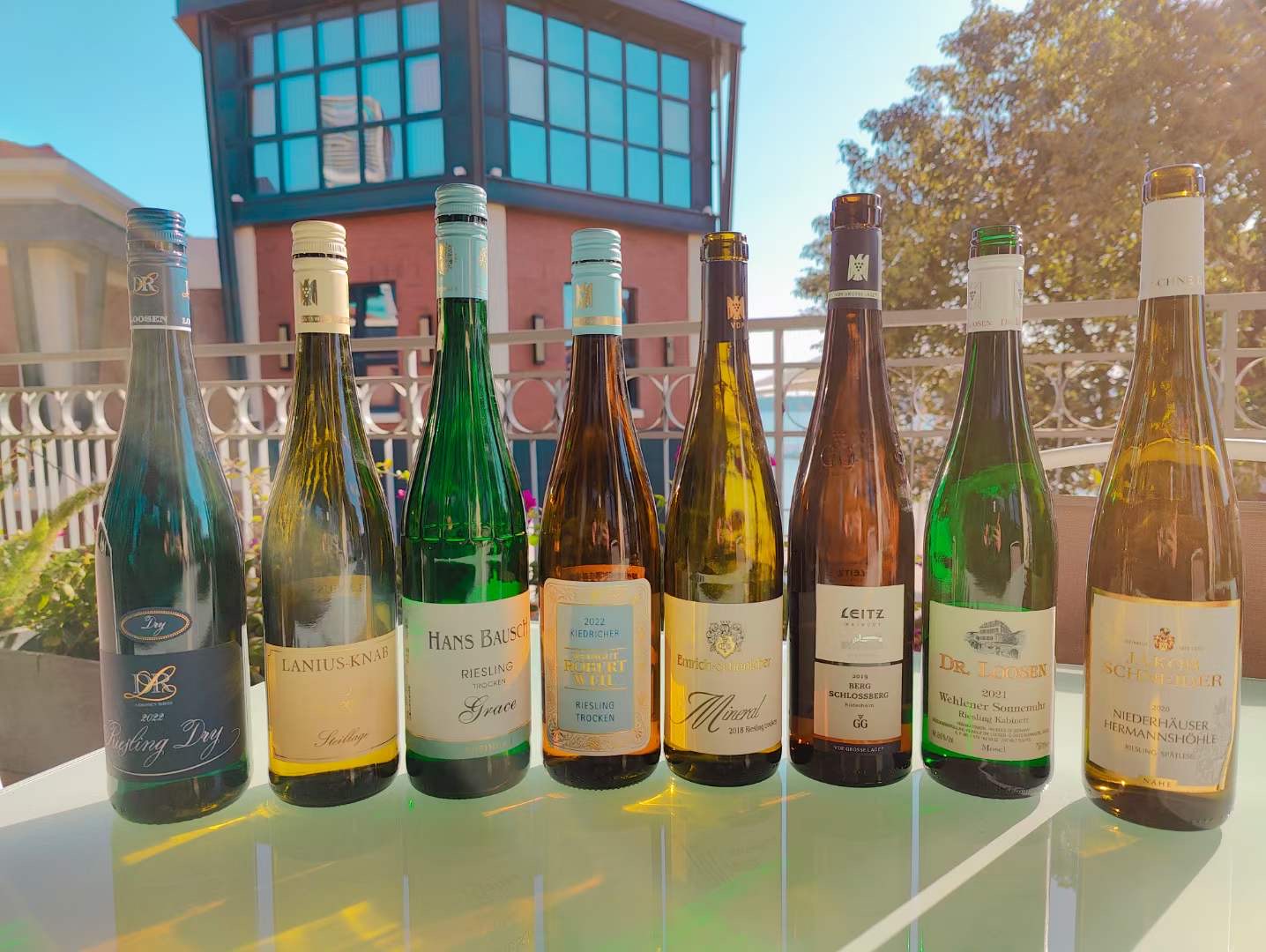
To be (slightly sweet) or not to be (slightly sweet): getting wine balance right is easier said than done
In addition to the changes in grape varieties, another big modification in German wine is its degree of residual sweetness. In the past, the largest proportion of Germany’s wine was semi-sweet and sweet; for example, in 1985 the classically dry wines (or Trocken in German, which means dry) only accounted for 16.3% of the total annual volume of wine produced. But by 2010 Trocken’s share of the German wine production had grown to 40.2%, and in 2021 this percentage was even larger (48.2%). For the sake of perspective, sweet and semi-sweet wines now only account for 31.2% of German wine production.
The reasons for this shift are numerous, and cannot really be simplistically reduced to market demand, as is all-too often done. Undoubtedly, the market does demand a newer, drier German wine style, more like the Grosses Gewachs (GG) wines made by the wineries that are members of the VDP group of producers. In fact, more and more GG or GG-styled wines are coming to the market, as the pursuit of extremely dry, extremely low residual sugar wines is rampant. But as is always the case when new phenoms are created, there is the other side of the coin and a real problem for German wine today, one that is glossed over at every turn and chance as nobody wants to talk about it much. But the dirty little secret of Germany’ wine is just how many of the GG and GG-like wines taste unbalanced when not downright bitter and unpleasant. It is a well-known fact that wines made with aromatic grape varieties benefit from a moderate amount of residual sugar, which not only can increase complexity, prolong the aftertaste, provide greater balance, but also make for far food-friendlier wines. There is no doubt that the pursuit of extreme dryness will increase the difficulty in pairing such wines with meals, as any preparations that have elements of sweetness will clash with bone-dry, high-acid wines such as many of Germany’s white wines are today. Even worse, carrying the alcoholic fermentation to completion will unfailingly give not just dry wines, but also wines much higher in alcohol, such that German wines now risk losing one of the greatest trump cards they had to show, that of wonderful flavour and complexity at only 9-11% alcohol by volume. To be crystal-clear, no other wine in the world can do as much with similar style and depth as the best from Germany. In ultimate analysis, what all this does is it reduces the pleasure of drinking, for good wine, never mind great wine, is not about a single element (“I want my wine dry!”), but about balance. No doubt, German wine lawmakers and producers have quite a bit on their plates to think about.
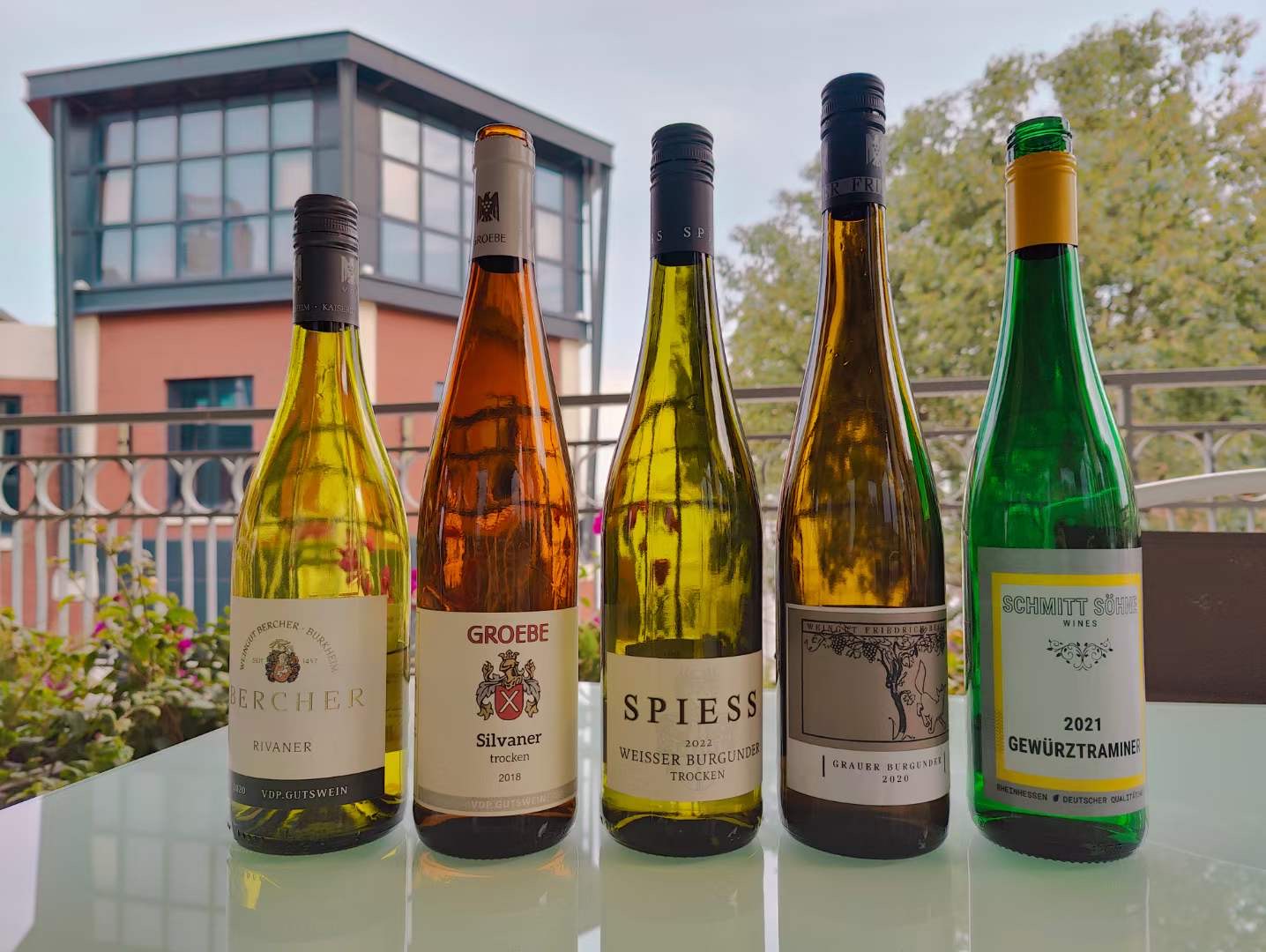
The wines in this tasting report
All the wines in this report were tasted by Yumi Liu in the month of December 2023 in China, where she lives and works. Please note that many more wines from some of the wineries that appear in this report, such as for example Bercher and Baron Knyphausen were tasted and will be reported upon by Ian D’Agata in part 2 of our German wine article out next week.
Alfred Merkelbach.
Located in Mosel, is managed by brothers Alfred and Rolf, and covers no more than 3.2 hectares, all of which are located in the Urziger Wurtzgarten, one of the warmest vineyards in Mosel’s microclimate, and in the Kinheimer Roseberg, a vineyard with grey slate that produces a cool Riesling character. The winery is a traditional Mosel dessert wine school, where the harvest is done in one go and the grapes are sorted for the different vintages, fermented and matured in large capacity old barrels.
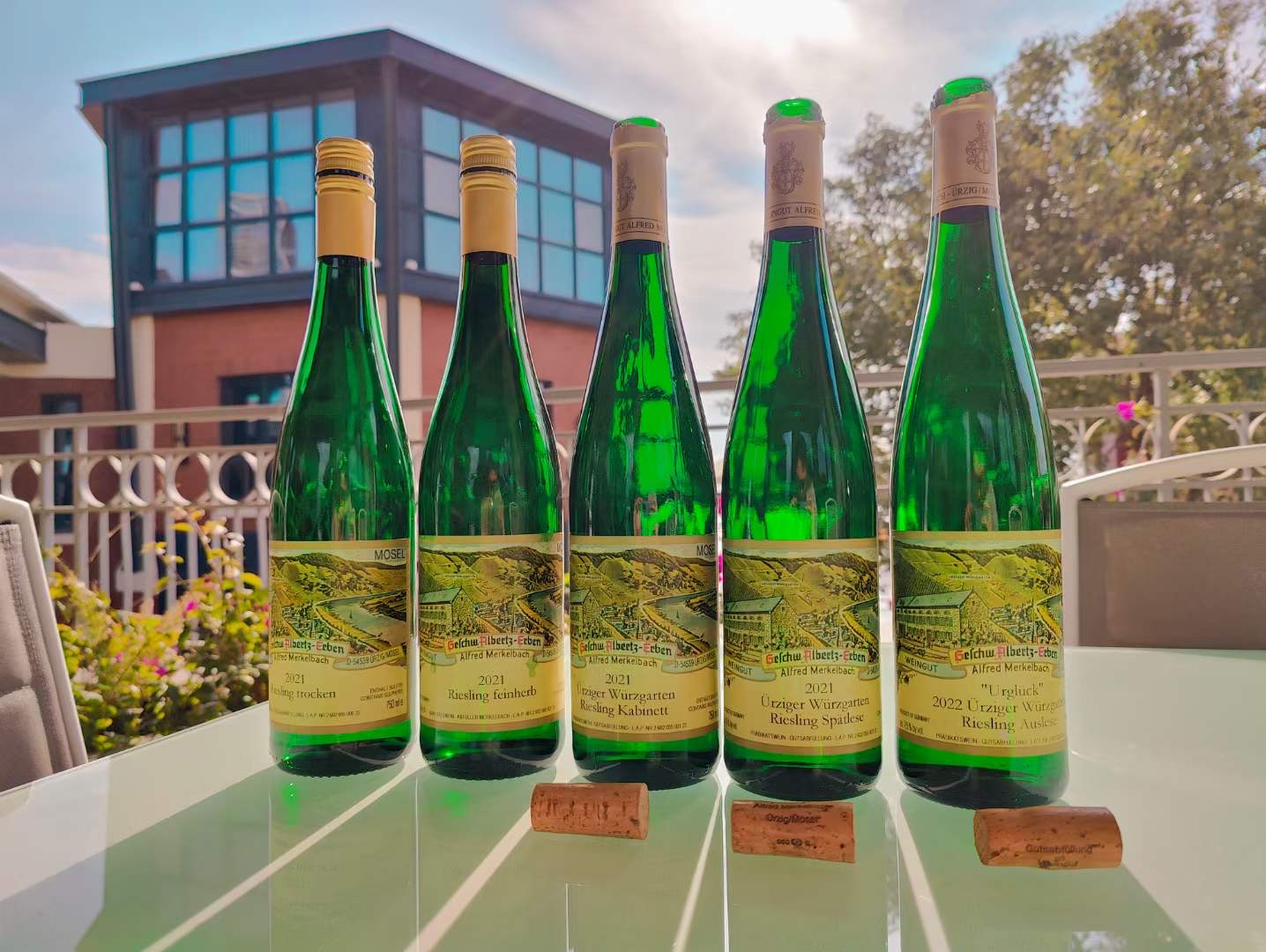
Alfred Merkelbach 2021 Riesling Trocken Mosel 90
Light lime color. Lemon and teak on the nose, with a pleasant acidity on the palate and a residual sugar on the finish, overall balanced and easy to drink. Drinking window: 2023~2028
Alfred Merkelbach 2021 Riesling Feinherb Mosel 89
Light lime color, the nose and mouth are full of fruit aromas and flavors such as citrus, apple, small white flowers. Reportedly off-dry in taste, with medium acidity, there’s a hint of bitterness on the finish. This is suitable for simple meals. Drinking window: 2023~2028
Alfred Merkelbach 2021 Urziger Wurtzgarten Riesling Kabinet Mosel 89
Pale lemon yellow. Compared to the previous two wines from Merkelbach, the aroma is clearly more intense, with grapefruit, yellow peaches, small white flowers very obvious and intense. Oily in texture but given a penetrating quality by high acids, the high acidity in the mouth buffers somewhat the very pronounced sugar content, but this may be too sweet for those looking for a bone-dry white wine. Hints of tropical fruit and orange peel flavours persist nicely on the medium-long finish. Drinking window: 2023-2030.
Alfred Merkelbach 2021 Urziger Wurtzgarten Riesling Spätlese Mosel 91
Bright straw yellow. Tropical fruit aromas of passion fruit mix with orchard fruit such as yellow apple and peach, complicated by acacia flowers. In the mouth, there is a richer, sweeter presence of honey, aged orange peel and grapefruit peel but the very high acidity makes the saliva come out in waves, leaving the mouth feeling fresh and clean. Nicely round and glyceral, this concentrated, focused wine finishes long with a bit of minty herbaceousness. I liked this wine’s overall complexity and balance. Drinking window: 2023-2033.
Alfred Merkelbach 2022 Urziger Wurtzgarten Riesling Auslese Mosel 86
Bright golden color. The nose is a little startling, offering a raw green note of pungent herbs. The flavours are very similar (musk, dry spices, mint), but it all leaves a not very pleasant feeling behind. A bit of a pity, really.
Baron Knyphausen.
Baron Knyphausen 2021 Roter Riesling Rheingau 93
Golden yellow color. Intense citrus, peach, and apple aromas, with honey, and golden acacia blossom for added complexity. Then follows with a pronounced taste of candied fruits and walnuts in the mouth. While this seems to have a residual sugar presence, it is actually a dry white wine, but the ripe fruitiness and its glyceral sensation leaves an impression of sweetness. The finish is classically dry and clean. A beautiful wine that will surprise pleasantly all those who have never tasted a Roter Riesling wine before, this boasts excellent balance and integration of fruit and acid. Well done. Roter Riesling is not a clone or biotype of Riesling, but rather a distinct variety that has been around for centuries but that is now making a comeback. Today, the Baron Knyphausen winery is one of the leading commercial growers of this high-quality grape. Drinking window: 2023-2030.
Bernhard Huber.
The winery’s vineyards cover 28 hectares, with a total of four grand cru vineyards, namely Bienenberg (Malterdingen), Alte Burg, Schlossberg (Hecklingen) and Sommerhalde (Bombach). The estate’s flagship single vineyard, Wildenstein, is actually certified by the VDP as an entire Grand Cru together with Bienenberg. The winery’s oldest vines were planted in the 1950s, and planted to 70% Pinot Noir and 15% Chardonnay, with other varieties including Pinot Blanc, Pinot Gris, and Freisamer, and a little Muscat and Müller-Thurgau.
Bernhard Huber 2019 Malterdinger Spatburgunder Baden 93
Ruby Red. The rich floral aroma is like walking into a small garden full of red roses, peonies, and violets. On the palate there is a very bright acidity and complexity of flavours of fruits such as rosehips and dried strawberries, along with leafy and earth tones. The aromas and flavours are intense and concentrated, while the finish is long and spicy. Made with Burgundy clones. Drinking window: 2023-2032.
Bercher.
Bercher 2020 Kaiserstuhl Rivaner Trocken Baden 87
Pale lime color. Then also aromas and flavours of lime that are crisp and perfumed. Light bodied but a little too simple and slightly short on the finish, with a touch of rising bitterness on the back end. This is a very good example of why making bone-dry wines (“trocken” wines) at all costs is just a bad idea, as they often end up being unbalanced, when not downright bordering on the bitter, such as in this case. Labeled as Rivaner, which is another name used in Germany for the better-known Müller-Thurgau. Drinking window: 2023-2025.
Bercher 2019 Jechtinger Eichert Grauburgunder Erste Lage Baden 90
Pale golden yellow in color. The nose is dominated by toasty, nutty-vanilla aromas. Then more slightly oxidized vanilla, creamy toast and caramel flavours on the palate. Full-bodied and oily, with medium acidity and some spice on the finish, this is a Pinot Grigio with a lot of character. The grapes were sourced in the first-growth Eichert vineyard; one third of the wine was aged in large oak barrels and the rest in stainless steel.Drinking window: 2023-2030.
Dr. Bürklin-Wolf.
This famous Pfalz estate is a pioneer in the transformation of German viticulture. One of the Pfalz’s world-renowned “three B’s” (the estates of Burklin-Wolf, Bassermann-Jordan and von Buhl), Burklin-Wolf was founded in 1597 in the heart of the Palatinate, and over the course of several generations the estate’s vineyards were expanded to eighty-five hectares. The vineyards are planted mainly with Riesling, as well as Pinot Blanc, Pinot Noir and small quantities of Cabernet Sauvignon and Merlot. The winery has been practicing biodynamic methods in the vineyard since 2001 and was certified Biodyvin in 2008.
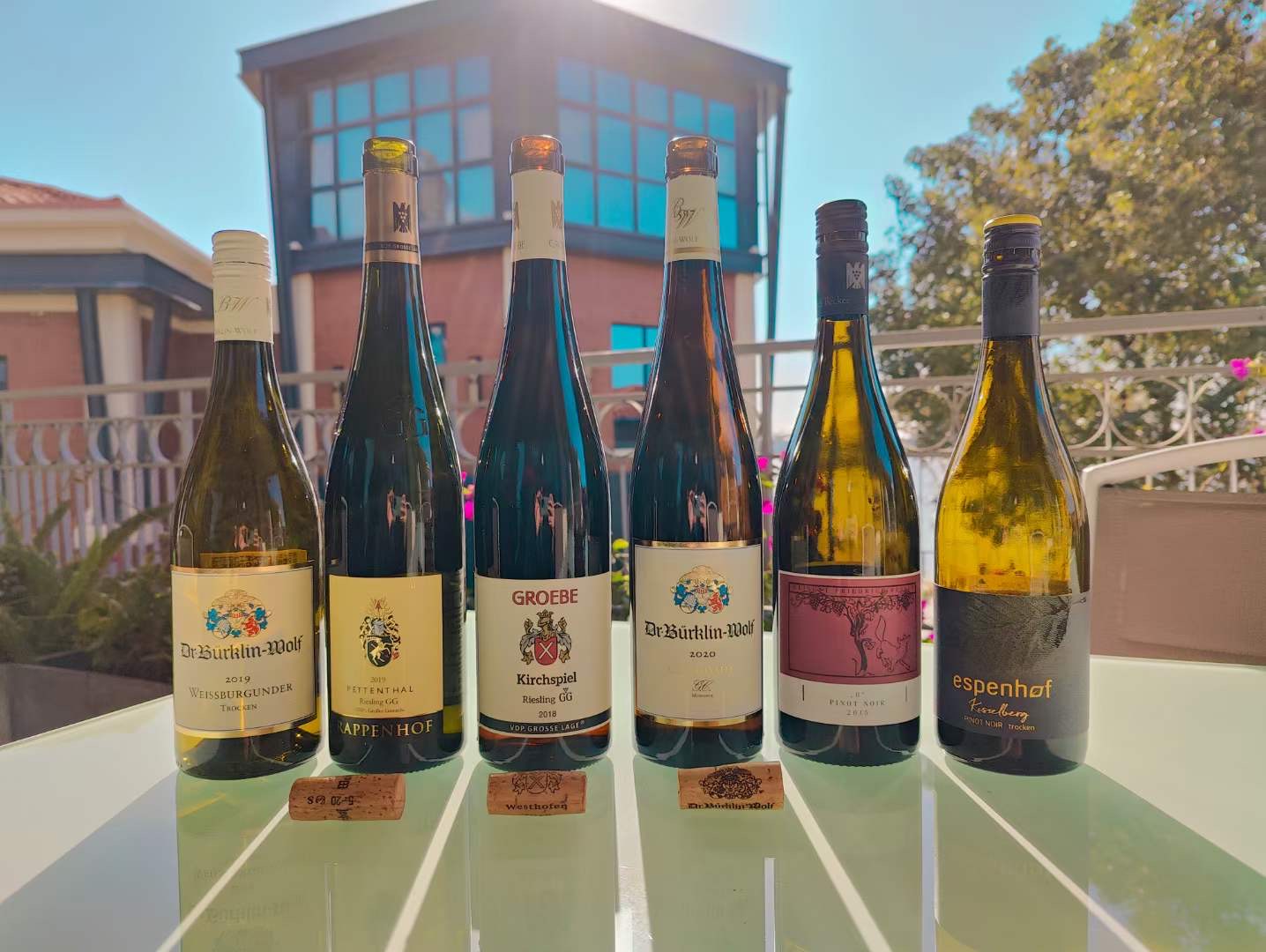
Dr. Bürklin-Wolf 2019 Weissburgunder Trocken Pfalz` 91
Bright and clear lemon yellow colour. Open-knit lemon, grapefruit peel and papaya aromas and flavours are pretty and accessible. Then pleasant acidity in the mouth, with a medium body, harmonious oiliness, and a medium-long finish with a hint of spiciness. Even though this is not the longest wine you will ever taste, it is an absolutely lovely Pinot Blanc wine that is very faithful to the variety (Pinot Blanc is the same thing as Weissburgunder, which is the German name for the variety). Drinking window: 2023-2030.
Dr. Bürklin-Wolf 2020 Gaisbohl GG Riesling Pfalz 91+
Bright straw yellow. Aromas and flavours of peach and fresh citrus, with a hint of vanilla. Nice acidity, a multi-layered mouthfeel and plenty of youthfulness all hint at considerable aging potential. The Gaisbohl is the winery’s exclusive vineyard (monopole) in Ruppertsberg; it has a rich soil, but with gravelly deposits that along with the clay layers give the wine structure and bright acidity. Drinking window: 2023-2032.
Dr. Loosen.
Dr. L 2021 Dry Riesling Mosel 89
Lime color. Lime and grapefruit peel aromas dominate on the nsoe and in the mouth. Crisp and easy to drink, this is a simple, easygoing wine made with bought grapes that offers a good introduction to the Dr. Loosen style. Drinking window: 2024-2030.
Dr. Loosen 2021 Wehlener Sonnenuhr Riesling Kabinett Mosel 90
Pale lemon yellow. Typical Mosel aromas and flavours of white flowers, lime and grapefruit. Cool and crisp in the mouth, boasting very high acidity, a light body, and a medium-long finish. There is obvious residual sugar here (the Kabinett category allows up to 9 g/L of residual sugar), but this showcases good balance. Drinking window: 2024-2030.
Emrich-Schönleber.
Emrich-Schönleber 2018 Riesling Mineral Trocken Nahe 89
Bright yellow color. Exuberant aromas of ripe apples and pear. High acidity in the mouth lifts flavours of candied apricots and peach syrup. Lacks a little vitality, I would recommend this for immediate consumption, as I do not think this will age for much longer. Drinking window: 2024-2025.
Espenhof.
Espenhof 2019 Kisselberg Pinot Noir Troken Rheinhessen 93
Ruby-red. Rich, lively and complex floral aromas dominate, with red fruit aromas more in the background. In the mouth there are flavours of rosehip sauce, wild cherries, strawberry cream cake, that are lifted by bright acidity. Medium-bodied, boasting velvety tannins, this leaves behind a beautiful mouth-feel on the long smooth finish. This very stunning Pinot Noir is highly New World in style, and very similar to the basic version of New Zeland’s Bell Hill Pinot Noir from Central Otago, one of that country’s best wineries and wines. Drinking window: 2023-2030.
Forster Winzerverein.
Forster Winzerverein 2019 Dornfelder Trocken Nahe 88
Deep purple-red color, the nose is slightly closed, even boasting a touch of game such that it doesn’t strike me as being particularly clean. Reddish-black fruits are more obvious in the mouth, but though this boasts nice freshness, there’s not much structure and complexity. Those who don’t mind a little funk in their wines will like this more than I. Drinking window: 2023-2024.
Freiherr Langwerth von Simmern.
Freiherr Langwerth von Simmern is one of the most prestigious wine families in the Rheingau. The family traces its roots back to at least 1215, and in 1411 it inherited Hattenheim Castle, which is still in the hands of the Simmern family today. One of the few families in Germany to be allowed to have the title of Sir Baron, in 1464 Johann Langwerth von Simmern was granted 8.25 hectares of vineyards for his role as a minister to Duke Ludwig, giving rise to the family’s long association with wine.
Freiherr Langwerth von Simmern 2015 Hattenheimer Nussbrunnen Riesling Kabinett Trocken Rheinhessen 93
Bright golden yellow color. Aromas of rich apple, citrus, dried fruit, and honey. Then bright acidity in the mouth, with flavours of ripe fruit and beeswax from ageing, leaving an illusion of a semi-sweet wine, but the clean finish in the mouth shows no residual sugar and a long lingering aftertaste. This wine is still very youthful and vibrant, and has the potential to age well. Drinking window: 2023-2035.
Furst Von Metternich.
Furst Von Metternich Riesling Sekt Rheingau 87
Made by the tank method, this is not unlike a very simple version of Prosecco, with thick bubbles, high residual sugar, and a short finish. But both this and prosecco can be much better. Drinking window: 2024-2025.
Jakob Schneider.
Jakob Schneider 2020 Niederhäuser Hermannshöhle Riesling Spätlese Nahe 93
Golden yellow color. Tropical fruits such as papaya, yellow peaches, salty candied fruits, dried fruits on the nose and in the mouth. Saliva-inducing high acidity in the mouth buffers the wine’s sweetness making for an impression of both good integration and harmony. Closes medium-bodied but tense, with a long aftertaste. Drinking window: 2024-2032.
Jean Stodden.
Jean Stodden 2019 Spatburgunder Ahr 93
Bright red. The cool nose is a little closed at first, then opens with aeration to offer light raspberry, wild cherry and rose petal aromas, followed by some minerality, earth, and graphite. Then similar flavours in the mouth, with a seemingly feather-light body that fills the mouth with a long finish. A basic wine with such complexity and concentration, it deserves to be praised: there’s a lot of wine for the money here. However, make sure you decant ahead, as this is made in a more serious style. Drinking window: 2023-2032.
K.F. Groebe.
Founded in 1763, the winery is located in Westhofen in the south of Rheinhessen and has been a member of the German VDP elite winery association since 1999. The winery’s nine hectares of vines are currently concentrated in the Aulerde, Kirchspiel, Morstein und Steingrube vineyard areas of Westhofen. More than 70% of the hectarage is planted with Riesling, 11% with Pinot Grigio, 8% with Pinot Noir, 8% with Silvaner, plus Scheubere and Gewürztraminer.
K.F. Groebe 2018 Silvaner Trocken Rheinhessen 89
Bright straw yellow color. The use of barrels is obvious, with the coffee and caramel flavours too prominent, overpowering Silvaner’s pretty fresh citrus, mineral and herbal nuances. Those who don’t mind a heavy dose of oak in their white wines will like this more than I did. I’m a big fan of K.F. Groebe’s wines that I always drink very happily, but in this case, I feel compelled to say that it’s a pity when too much craftsmanship overshadows the character of the variety. Drinking window: 2025-2028.
K.F. Groebe 2018 Westhofener Kirchspiel Riesling GG Rheinhessen 92
Straw-yellow colour. The nose is rich in aromas of lime, citrus and white flowers, and the mouth is crisp with similar flavours. Cold acidity and rocky minerality enhance the powerful, dried fruit finish. A Riesling wine with some age on it, this is memorable: well done! This wine is made with grapes selected from two very good local VDP Grand Cru terroirs, the Aulerde and the Kirchspiel. The soil of the Aulerde is mainly loamy and clayey, which allows for heat retention in the grapes, but it also has good drainage thanks to its south-eastern and eastern slopes and the sandstone presence in the soil. The Kirchspiel grapes come from the core of the vineyard where the soil contains vitrified marl, a large amount of limestone, and a small portion of limestone-weathered mud. The Aulerde gives the wine a rounded, powerful mouthfeel, while the Kirchspiel gives it a strong, structured frame. Drinking window: 2023-2032.
Lanius-Knab.
Lanius-Knab 2020 Riesling Trocken Steillage Mittelrhein 89
Some oxidization on the nose. Then yeasty, tropical fruit and ripe apple on the palate, that comes across as rich and oily. The finish hints at a touch of gasoline. Drinking window: 2024-2027.
Leitz.
Leitz 2019 Berg Schlossberg Riesling GG Rheingau 90
Golden yellow color. On the nose there is a clear sense of evolution, dominated as it is by oxidative nuances such as hints of yeast and toast. In the mouth, there is ripe apple and vanilla flavors, with a rich oily mouthfeel, moderate acidity and a spicy finish. Drinking window: 2023-2030.
Nick Steinzeug.
Nick Steinzeug 2021 Manzoni & Sauvignon Natural Wine Rheinhessen 90
Muddy straw yellow. The nose offers lemon peel, citrus and honeysuckle aromas. Then clean in the mouth, with the acidity both pleasant and bright, but the fermentation in clay pots (steinzeug is the German word for pottery), brings forth a bit of oxidation and slightly chewy tannins. The savory finish does not speak too much of either one of the two varieties, which is a pity, but this is still a lovely little wine that will prove very food-friendly! This is a blend of Incrocio Manzoni (a fine Italian crossing) and Sauvignon Blanc. Drinking window: 2023-2024.
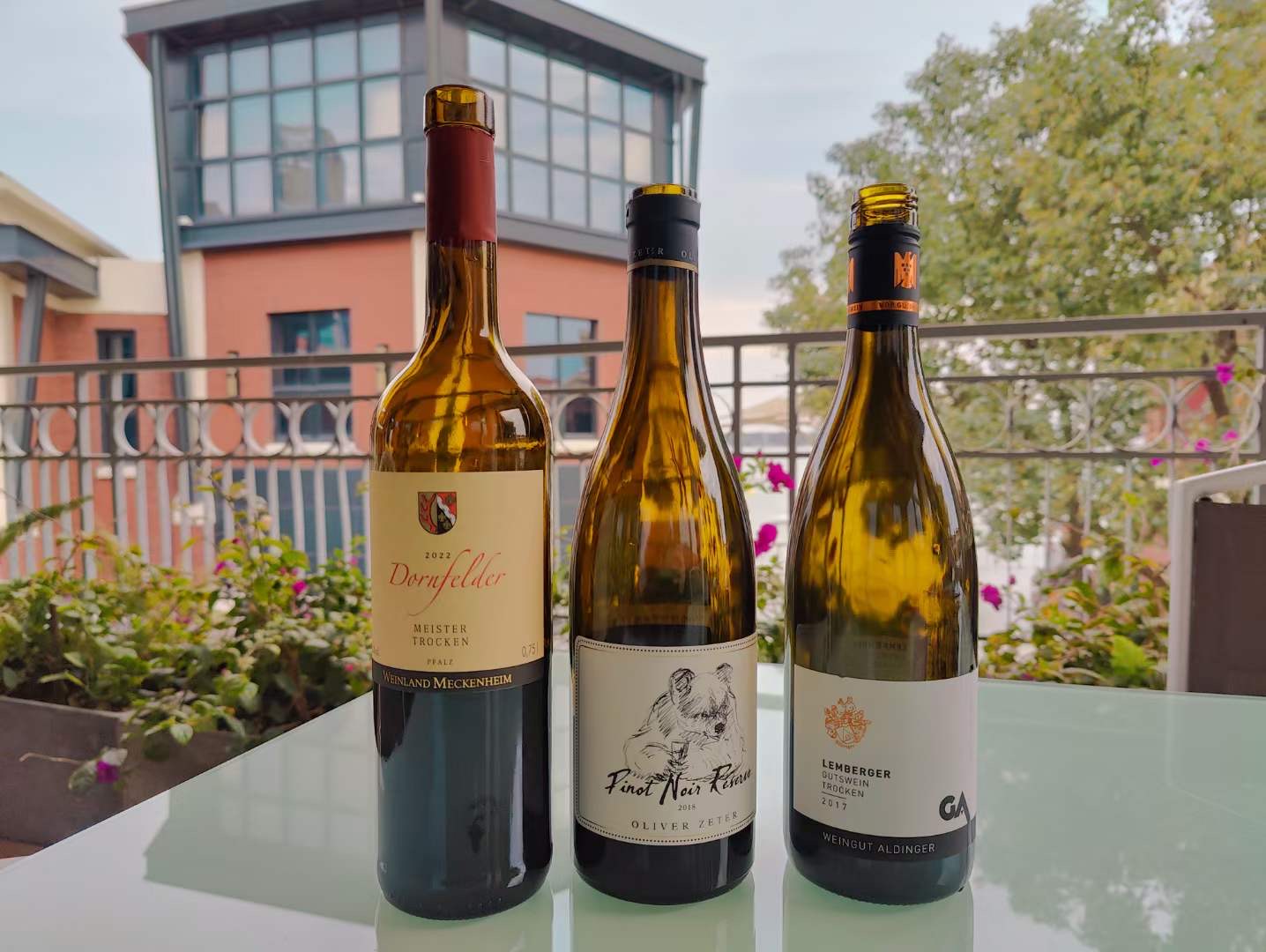
Oliver Zeter.
Oliver Zeter 2020 Pinot Noir Pfalz 91+
Pale ruby red. Plenty of fruity aromas of cherries and cranberries, with bright, juicy acidity on the palate. Then bold flavours of red currants, raspberries, dried strawberries and some dried flower petals. Powerful wine, with fine tannins, along finish and great ageing potential. Drinking window: 2023-2030.
Meckenheim.
Meckenheim 2022 Dornfelder Trocken Pfalz 89
Bright purple-red color. Clearly spiced with white pepper nuances to the red fruit flavors. On the nose and in the mouth it is fresh, simple and juicy, like a Beaujolais Nouveau wine. Drinking window: 2024-2025.
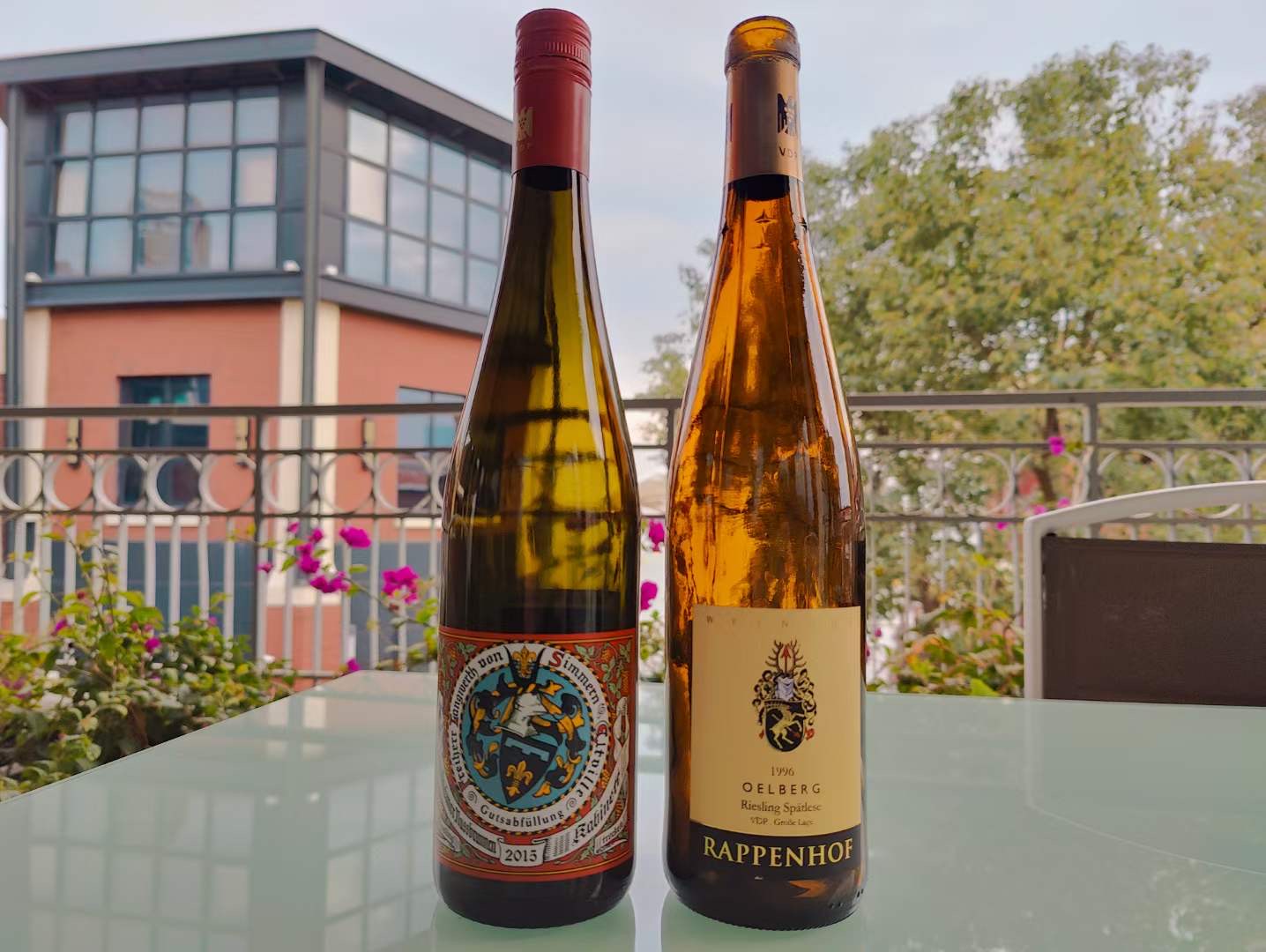
Rappenhof.
The winery is located in Rheinhessen’s Alsheim region, characterized by fertile land. Klaus, the first owner of Rappenhof, liked to drive through the vineyards alone in a horse-drawn carriage. Hence the name Rappenhof which means “black horse” (because of the owner’s ancestors’ passion for horse-drawn carriages with fiery black horses). The winery’s current owner, Elisabeth Muth, is the thirteenth owner. The 130 hectares of vineyards in the three Rhine villages of Alsheim, Guntersblum and Nierstein are planted mainly with Riesling.
Rappenhof 2019 Nierstein Pettenthal Riesling GG Rheinhessen 90
Nose of sourdough bread, cider, herbs, this comes across as slightly oxidized. Then also slightly oxidized in the mouth, with hints of yeast, toast, minerally rust, and a hint of precocious evolution in bottle. I’m not sure if this is due to this specific bottle, and if there is bottle difference variation possible, but I think this wine potentially could offer much more than what it is showing on this day, so I’ll be generous with my scoring. The long finish is certainly impressive. Clearly, the GG on the label stands for Große Gewächs, meaning the wine is made with grapes grown in one of Germany’s great growth vineyards. Which is exactly what the Nierstein Pettenthal Grand Cru is a famous red clay sandstone vineyard (Roter Hang) that has long been linked with some of the Rheinhessen’s best wines. Drinking window: 2023~2024
Rappenhof Nierstein Oelberg Riesling Spätlese 1996 Grosse Lage Rheinhessen 93
Bright amber color. Rich and lively aromas including loquat paste and candied fruit. In the mouth, this beautiful wine spreads out over the entire palate with flavours of both candied and dried fruits, beeswax, all lifted by lively acidity. This highly concentrated wine finishes long with a bit of minty herbaceousness. Drinking window: 2023-2030.
Robert Weil.
Robert Weil 2021 Kiedricher Riesling Trocken Rheingau 91
Medium straw-yellow. Rich floral and fruity nose with hints of undergrowth. Then deep savory minerality in the mouth. Closes long with plenty of overall freshness, crispness, and tension. Made with grapes picked from Grand Cru and Premier Cru vineyards characterized by various soils, including loess and loam. Drinking window: 2023-2030.
Schmitt Sohne.
Schmitt Sohne 2021 Gewürztraminer Rheinhessen 85
Pale lemon yellow. Not much in the way of aroma (which is very surprising, as Gewürztraminer is an aromatic variety). In the mouth, this is also rather bland, with little or no distinguishing flavour other than a pronounced sweetness. There is nothing faulty about this wine, but it is just too simple, which is a real pity. Germany does make very good Gewürztraminer wines, even though the variety has fallen on hard times in the country (according to the 2021 data of the German Association, Gewürztraminer is now planted on only 1% of the total area in Germany). Drinking window: 2023-2024.
Spiess.
Spiess 2022 Weisser Burgunder Trocken Rheinhessen 85
Pale straw-yellow. The aromas are very floral and intense, but almost too intense such that they become unpleasant. In the mouth the acidity is medium-level, but this also lacks complexity; had I tasted this blind, I am not sure I would have recognized this as a Pinot Blanc wine (usually called weisser burgunder in Germany as it is in this case). Drinking window: 2023-2025.
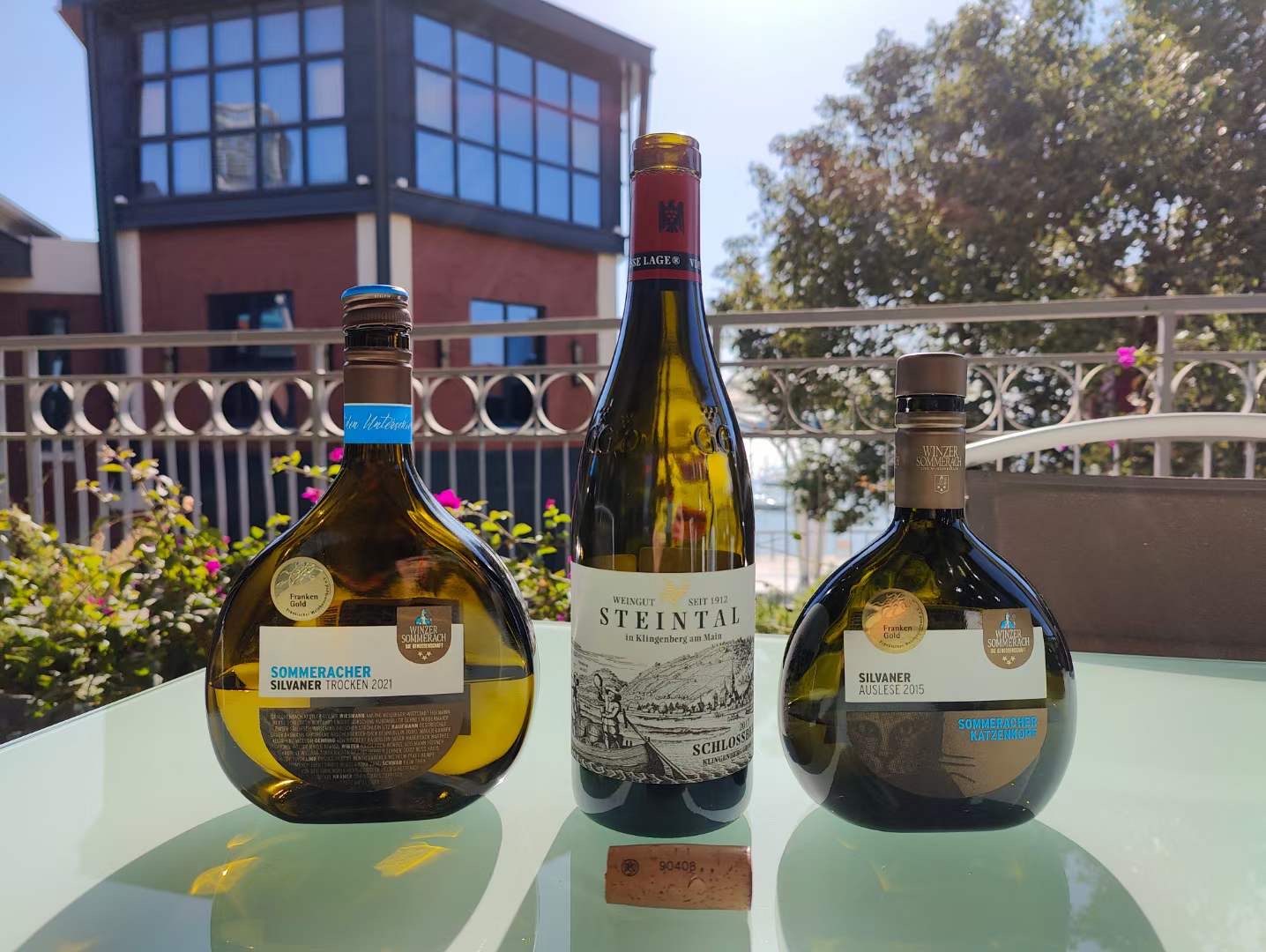
Steintal.
Steintal 2017 Klingenberg Schlossberg Spaetburgunder GG Franken 92+
Gemstone red. The nose is reductive at first, which clears with aeration to offer aromas of dried rose petals, black tea, and minerals. In the mouth, the wine is deep and concentrated, savory and boasts fine tannins.
Finishes with noteworthy austerity and a lot of power. I suggest decanting two hours ahead. Drinking window: 2023-2032.
Weingut Friedrich Becker.
Weingut Friedrich Becker 2020 Grauer Burgunder Pfalz 90
Golden yellow colour. Aromas of jasmine, chamomile, and peaches. Then dried apricot flavours in the mouth, with moderate acidity, youthfully chewy tannins (because the wine was kept soaking on the skins), and a little salty minerality. Finishes clean and long. Make sure you drink this not too cold, slightly chilled. Grauer Burgunder is the German name for Pinot Grigio. Drinking window: 2023-2030.
Weingut Friedrich Becker 2020 Petit Rose Pfalz 90
Bright orange-pink color. The nose is like being in the midst of a field of flowers, with string aromas of roses and violets accompanied by notes of peach. In the mouth, the flavours are clean and simple with red fruits (strawberries and cherries) dominating. A clear residual sugar sensation mixed with chewy tannins accompanies the long finish that features a note of bitter grapefruit rind. A simple, pleasing and highly enjoyable wine . This is a blend of 75% Dornfelder, 21% Portuguiser and 3% Pinot Noir. Drinking window: 2023-2024.
Weingut Friedrich Becker 2016 SpatBurgunder “B” Pfalz 90
Bright ruby red color. Slightly funky aromas of fur and wild yeast dominate on the nose. In the mouth it is clean, with dried flower petal, fresh hawthorn and dried red fruit flavours. High acidity and supple tannins leave an impression of a well-structured wine. The long finish has a repeating touch of game and of cracked pepper. Made from thirty years old vines planted on crusty tuff soil, with spontaneous fermentation, this spends fifteen months in small oak barrels. Spat Burgunder is the German name for Pinot Noir. Drinking window: 2023-2025.
Winzer Sommerach.
Winzer Sommerach 2021 Katzenkopf Silvaner 2021 Kabinett Trocken Franken 90
Lime green. Very typical Silvaner aromas, including apple, pear, chamomile and asparagus. Then bright flavours of chlorophyll, pear, apples and a hint of minerality. Bright and refreshing acidity nicely carry the deep flavours on the
savory, transparent, light-bodied, fresh long finish. Ideal with lettuce salads, vegetarian dishes, and anything involving asparagus and artichokes. Drinking window: 2023-2030.
Winzer Sommerach 2015 Katzenkopf Silvaner Auslese Franken 93
Bright amber color. Nose full of dried fruit, honey, kumquat, aromas, in the mouth with honeydew melon, tropical fruit, beeswax, acacia. The acidity is high and harmonizes well with the sweetness, the wine is rounded and well defined. The finish is long and outstanding. Franken’ is the premium appellation for Silvaner, thanks to its rich limestone soils, Triassic-age crustal tuffs, gypsum marl, in which Silvaner can develop its most outstanding characteristics, and in which Silvaner is allowed to be vinified in GG. And Germany’s traditional slender bottle is different, Franken in the local special bottle type Bocksbeutel, (beutel refers to the Chambers handbags, meaning that this special bottle in addition to beauty and practicality is designed for people to facilitate the carrying of the design, easy to install on both sides of the saddle,) Drinking window: 2023-2030.
Weingut Jurgen Ellwanger.
Weingut Jurgen Ellwanger Hebsacker Berg 2018 Lemberger Trocken GG Wurttemberg 93
Fuchsia color. Aromas and flavours of violets and black fruits such as black plums and blackberries explode out of the glass and on the palate with juicy nuances of licorice, and tea. Closes with medium acidity, tannic but not grippy. A very elegant little wine, made with Lemberger that can be made as a Grand Cru wine in Wurttemberg (this is a a Große Gewächs wine). Drinking window: 2023-2028.
Robert Weil NV Riesling Sekt Rheingau 92
Fine and dense bubbles. Fruity and floral aromas, the mouth is absolutely dry, but very rounded, with the fruit flavours of peaches, apricots, and small white flowers nicely persistent. Although this is a non-vintage wine, it does not smell or taste overly-simple; actually, for the money it is very outstanding, boasting a high price/performance ratio. This is made by the traditional method of secondary fermentation in the bottle. Drinking window: 2024-2027.

 中文
中文

